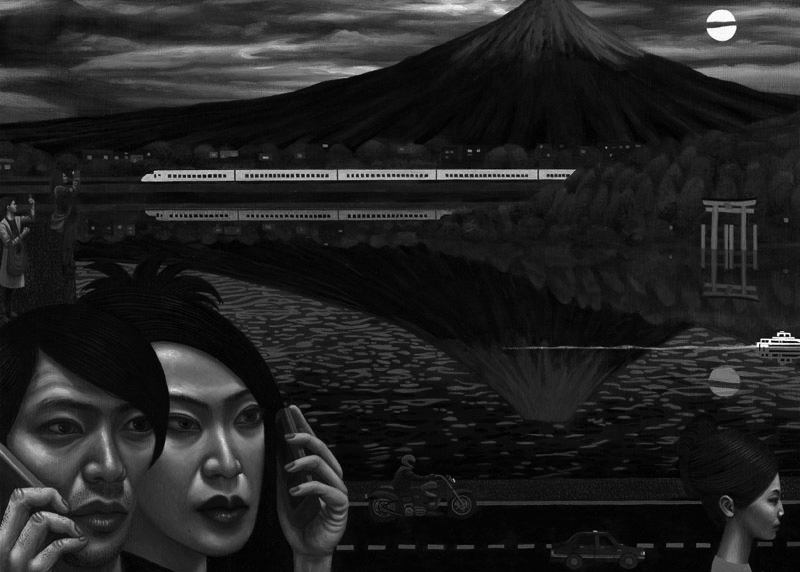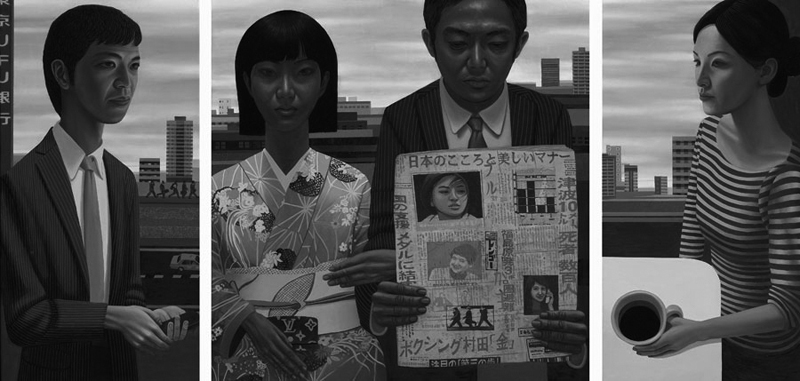 Recent paintings made in Japan will be showing at my exhibition ‘In The Footsteps of Hiroshige: The Tokaido Highway and Portraits of Modern Japan’, at the National Portrait Gallery from June 20th to September 15th (then touring the UK until May 2014). The exhibition is the result of being awarded the 2012 BP Portrait Award.
Recent paintings made in Japan will be showing at my exhibition ‘In The Footsteps of Hiroshige: The Tokaido Highway and Portraits of Modern Japan’, at the National Portrait Gallery from June 20th to September 15th (then touring the UK until May 2014). The exhibition is the result of being awarded the 2012 BP Portrait Award.
My proposal for the award was to travel in the footsteps of the Japanese woodblock print artist Ando Hiroshige (1797–1858), who in 1832 travelled along the Tokaido Highway, an old trading route that ran from Tokyo to Kyoto, producing a series of woodblock prints showing the people he met and the landscapes he experienced along the path. The prints now serve as a valuable artistic document of life in Japan at that time. I was interested in producing contemporary equivalents, documenting the people and places of modern Japan, 180 years after Hiroshige made the same journey.
The journey started in the bustling capital city of Tokyo, and, drawn to its densely crowded streets, I painted hundreds of residents one by one, directly from life. Visiting other major cities along the route, I painted other features of modern Japan such as salary men, sushi restaurants and department stores. As the highway moves out of cities and into rural areas, elderly rice farmers work their fields, their backs permanently bowed, skin leathery and wrinkled from a lifetime of farming. While visiting these areas, I also had the opportunity to experience aspects of traditional Japanese scenes such as hot springs, fireflies and red autumn leaves.
Finding the modern and urban ever present in the rural, I included elements of the industrial within images of nature: bullet trains cut through mountains, telegraph poles dot the landscape, tetrapods line the coastline. These, and other motifs, such as the mobile phone, are used to place the images in the contemporary world, while also helping to avoid nostalgic depictions of historical Japan. I would hope that my portrayal of familiar Japanese icons such as Mount Fuji, Geisha, Kabuki, Zen gardens and Sumo wrestlers have been presented in a fresh light.
Combining a sense of the real and unreal in these paintings was important to me, with realistically painted figures set against flattening space and illogical scale. I painted some works in monotone, to imbue them with a feeling of solitude and silence, which relates to my interest in urban alienation – the idea of people sharing the same close physical space, but mentally existing in separate worlds.
 This exciting opportunity allowed me to develop my interest in portraiture and create personal interpretations of Japan, while following in the footsteps of a great artist. I felt privileged to be the first portrait painter to respond to this subject matter, and I would hope that this exhibition generates further public interest in this fascinating country.
This exciting opportunity allowed me to develop my interest in portraiture and create personal interpretations of Japan, while following in the footsteps of a great artist. I felt privileged to be the first portrait painter to respond to this subject matter, and I would hope that this exhibition generates further public interest in this fascinating country.
Japan Portraits, a 120-page colour hardback catalogue of work made in Japan, is available at The National Portrait Gallery – foreword by Desmond Morris with an introduction by Donald Richie. A documentary about the artist painting in Japan is at www.vimeo.com/carlrandall/japanportraits.
Artist’s website: www.carlrandall.com


